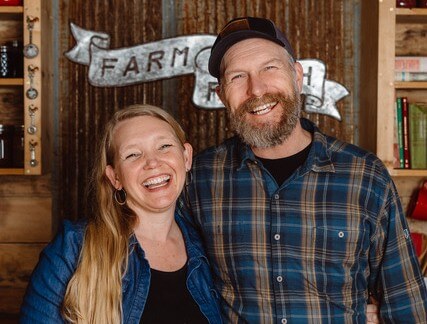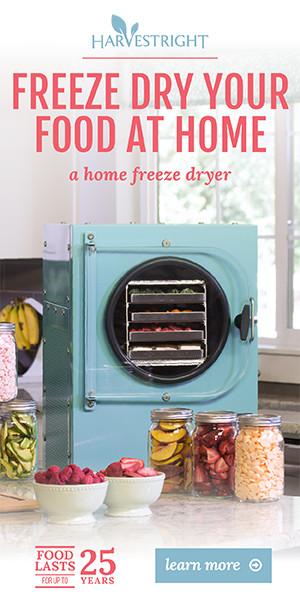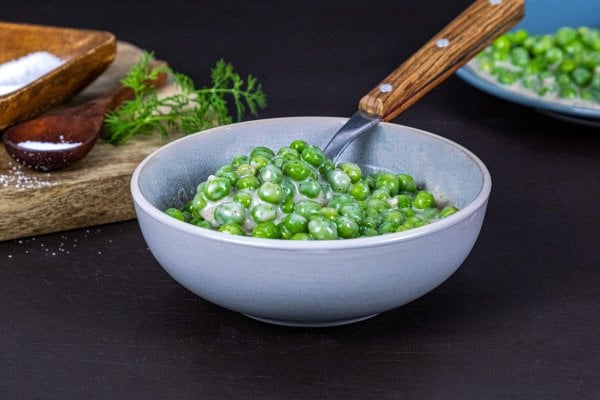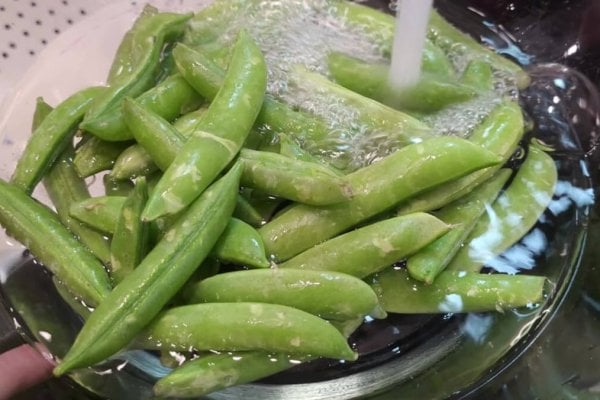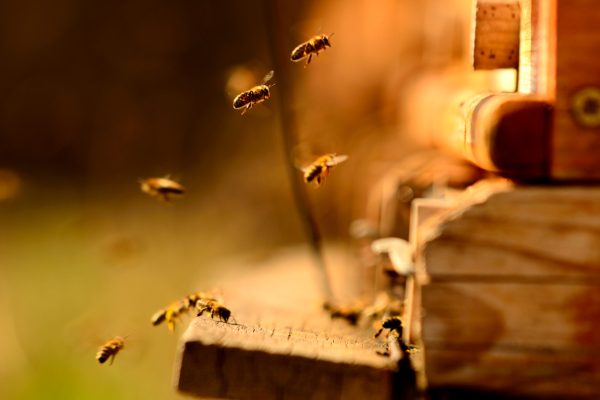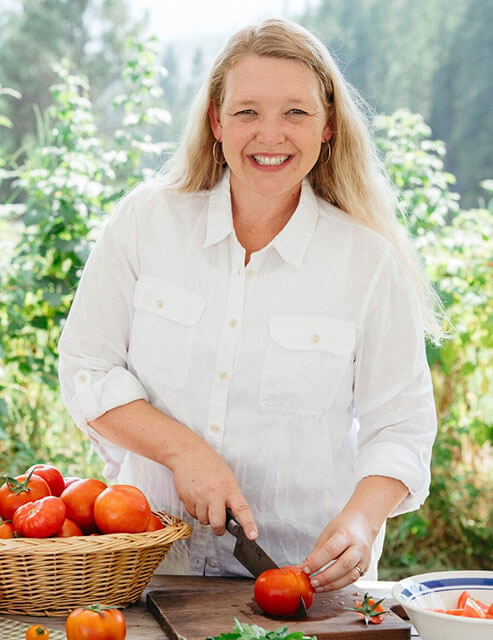Did you know you can make homemade raw milk cottage cheese without rennet? This recipe uses minimal supplies and has just two ingredients. Get ready to make homemade dairy products practical by processing your farm-fresh milk into the easiest cheese you’ll ever make!

Table of Contents
ToggleWhy We Love Raw Milk Cottage Cheese
We already had one dairy cow and milk goats, so when we added another dairy cow to the homestead, we had to make sure we had a solid plan for what to do with all that raw milk.
This is a step beyond finding recipes that use a lot of milk. We needed to hone our milk preservation skills by making freeze dried milk, homemade kefir, easy instant pot yogurt, soft yogurt cheese, goat’s milk cheese, and this easy raw milk cottage cheese.
The raw cottage cheese process only works with raw milk, so if you are wondering if you can make cheese from store-bought milk, this particular recipe is not for you. Pasteurized milk will spoil instead of fermenting.
However, if fresh raw milk is very clean and in a clean container, it will change and ferment but won’t go bad. So, for best results, always start with milk as fresh as you can get it!

How to Use Raw Milk Cottage Cheese
Cottage cheese is wildly popular because you can use it in a variety of applications. You can serve cottage cheese as a snack with fresh herbs or a dash of pepper, as a side dish with a topping of fruit, or as a quick breakfast with a sprinkling of honey and toasted nuts or granola.
However, cottage cheese goes far beyond that. Check out these other ways to incorporate cottage cheese into your kitchen.
- Salads – Add cottage cheese to your favorite salad recipe for a boost of protein and creaminess.
- Ricotta Substitute – Use cottage cheese as a substitute for ricotta cheese in lasagna or cannelloni.
- Smoothies – Blend cottage cheese into your favorite smoothie recipe to make it creamy and add protein.
- Dips – Blend cottage cheese into your favorite dip to add a creamy and tangy flavor for vegetables or crackers.
- Baked Goods – Blend cottage cheese smooth and use in place of milk, heavy cream, yogurt, or sour cream in sweetbreads, pancakes, biscuits, baked oatmeal, and more.
- Eggs – To take scrambled eggs or frittatas to the next level, blend cottage cheese and whisk with your eggs before cooking.

The Homestead Kitchen
This recipe for raw milk cottage cheese was featured in issue No. 43 of the Homestead Kitchen magazine. If you are looking for a homesteading resource that can provide answers, guidance, encouragement, tips and tricks, or advice, this magazine was designed just for you.
As new homesteaders, it took us a lot of trial and error to overcome feelings of inadequacy. Now, we have made it our mission to share our journey and knowledge with others to help them bypass some of those growing pains.
With the Homestead Kitchen magazine, you will be put on the fast track to homesteading with confidence as we share how to overcome the big obstacles along with the little things that can make a huge impact on your success.
Now, the Homestead Kitchen magazine is available in print! So subscribe today and start enjoying this magazine in the palm of your hand.

How to Make Raw Milk Cottage Cheese
Supplies Needed
- 1 Gallon Jar w/ Lid – You can also use two half-gallon Mason jars with a canning ring or a rubber band to secure the cheesecloth.
- Cheese Cloth – Before using it for fermenting projects, always wash your cheesecloth and boil it for 5 minutes.
- Colander – A colander or large sieve works best.
- String – You can use kitchen string or a sturdy rubber band to hang your cheese.

Ingredients Needed
- Milk – One gallon of milk yields about three cups of cottage cheese, so increase or decrease as needed. Keep in mind that you’ll first need to make your culture, so more milk will be needed for your initial batch.
- Salt – To taste. We love using Redmond Real Salt because it’s filled with minerals, and we can buy it in bulk. Homesteading Hack: (Using that link for Redmond Salt will automatically give you 15% off your order!)



Step-by-Step Instructions
For the Base Culture:
- Fill the jar with milk until almost full (ferments bubble and foam, so leave some room), put a fresh piece of cheesecloth over the top, and screw on the lid.
- Set the jar of milk in a warm location (on top of the refrigerator, near the stove, or in a room with a wood stove) for as long as it takes to start getting thick. Your first batch can take anywhere from 2 to 10 days to start fermenting. Of course, this really depends on how warm your kitchen is and how many bacteria it has.
- Occasionally, smell the base culture. As long as it doesn’t smell putrid, you’re good to go. Because this culture will take days to turn into a clabber, it will definitely taste and smell strong. Don’t worry – you don’t have to consume this batch! This is just the starter. Your thickened milk may separate into curds and whey or look something like yogurt, maybe with little bubbles. Don’t be concerned when you see a lot of changes!
- Once it’s thickened and/or separated, you’re ready to start culturing fresh milk to get delicious clabbers (like cottage cheese!) that you can consume.



For the Cottage Cheese:
- Add 1/2 to 1 cup of the base culture to a fresh gallon of raw milk (adding 1 cup will help it ferment more quickly) and allow it to culture until it’s thoroughly separated into curds and yellow whey. You will lose volume during this process, so you’ll need a lot of culture to get a decent amount of cheese.
- Once you have curds and whey, line a clean colander with clean cheesecloth and set it over a bowl to catch the whey. You’ll need a spot to hang this up.
- Gently pour the culture into the cheesecloth in the strainer to strain the curds. Use string or a rubber band to tie the cheesecloth, then hang it over the bowl for about 12 hours until it breaks up nicely into little bits of curd.
- After it’s done, take it out of the cheesecloth. You could use the cheese just like this, but we’re going to make it a little more like cottage cheese.
- Add salt to taste and mix it in really well. This helps draw the moisture out even more. Put this cheese into a fresh piece of cheesecloth, making sure to get every last bit.
- Give the cheese a squeeze, then hang again for another 12 to 24 hours. After this hanging time, break up the curds into little pieces.
- If you want, you can salt again and keep hanging, but at this point, it’ll be the texture of a nice old-fashioned cottage cheese – crumbly but creamy in the middle. Feel free to add a little milk kefir or heavy cream to make it creamier.
- Add whatever flavors you’d like to the cheese: fruit, herbs, or other stir-ins.
- Store cottage cheese in an air-tight container in the refrigerator.
Did you try this raw milk cottage cheese recipe? If so, please leave a star rating and your comments in the recipe card below. Then snap a photo and tag us on social media @homesteadingfamily so we can see!

FAQ
Cottage cheese is a nutritious food with many health benefits. It’s packed with protein, calcium, and other nutrients. You can use it in many dishes, from breakfast to dessert, and it’s a great substitute for other cheeses.
Cottage cheese is usually a large curd or small curd variety. Large curd is typically made with rennet. This recipe does not use rennet, so it will yield smaller curds.
To make cottage cheese, you just need raw milk, salt, a jar, cheesecloth, a colander, and string.
Making raw milk cottage cheese at home is simple. Follow the easy step-by-step instructions in this tutorial.
Homemade raw milk cottage cheese is more nutritious and economical and lets you control the flavor and texture.
Cottage cheese is versatile and you can use it in many dishes. This tutorial shows you how to add it to salads, smoothies, and more. It also works great as a cheese substitute.
Using store-bought pasteurized milk or aging raw milk will not ferment but rather just spoil. For best results, always start with raw milk as fresh as possible.
One gallon of milk yields about three cups of cottage cheese.
Other Posts You May Enjoy
- Adding Another Dairy Cow to the Homestead
- Dairy Animals for the Homestead
- Process Raw Milk at Home Safely & Easily!
- Making Homemade Dairy Products Practical
- What to Do With Raw Milk
- Can You Make Cheese From Store-Bought Milk?
- Homemade Ice Cream Recipe for Ice Cream Maker
- Chevre Cheese Recipe (Goat’s Milk Cheese)

Raw Milk Cottage Cheese Recipe
Equipment
- Gallon Jar with lid
- cheesecloth
- Colander
- String
Ingredients
- 2 gallons milk divided… one gallon for the base culture, another gallon to make cottage cheese
- salt to taste
Instructions
For the Base Culture:
- Fill the jar with milk until almost full (ferments bubble and foam, so leave some room), put a fresh piece of cheesecloth over the top, and screw on the lid.
- Set the jar of milk in a warm location (such as above the refrigerator, near your stove or in a room with a wood-burning fireplace) for as long as it takes to start getting thick. Your first batch will likely take between 2 to 10 days to start fermenting. Of course, this really depends on how hot your kitchen is and how many bacteria it has.
- Occasionally smell the base culture. As long as it doesn’t smell putrid, you’re good to go. Because this culture will take so many days to turn into a clabber, it will definitely taste and smell strong. Don’t worry – you don’t have to consume this batch! This is just the starter. Your thickened milk may separate into curds and whey or look something like yogurt, maybe with little bubbles. Don’t be concerned when you see a lot of changes!
- Once it’s thickened and/or separated, you’re ready to start culturing fresh milk to get delicious clabbers (like cottage cheese!) that you can consume.
For the Cottage Cheese:
- Add 1/2 to 1 cup of the base culture to a fresh gallon of raw milk (adding 1 cup will help it ferment more quickly) and allow it to culture until it’s thoroughly separated into curds and yellow whey. You will lose volume during this process, so you’ll need a lot of culture to get a decent amount of cheese.
- Once you have curds and whey, line a clean colander with clean cheesecloth and set it over a bowl to catch the whey. You'll need a spot to hang this up.
- Line a clean colander with clean cheesecloth and set it over a bowl to catch the whey. You'll need a spot to hang this up.
- Gently pour the culture into the cheesecloth in the strainer to strain the curds. Use string or a rubber band to tie the cheesecloth, then hang it over the bowl for about 12 hours until it breaks up nicely into little bits of curd.
- After it’s done, take it out of the cheesecloth. You could use the cheese just like this, but we’re going to make it a little more like cottage cheese.
- Add salt to taste and mix it in really well. This helps draw the moisture out even more. Put this cheese into a fresh bit of cheesecloth, making sure to get every last bit.
- Give the cheese a squeeze, then hang again for another 12 to 24 hours. After this hanging time, break up the curds into little pieces.
- If you want, you can salt again and keep hanging, but at this point, it’ll be the texture of a nice old-fashioned cottage cheese—crumbly but creamy in the middle. Feel free to add a little milk kefir to make it creamier.
- Add whatever flavors you’d like to the cheese—fruit, herbs, or other stir-ins would be delicious.
- Store cottage cheese in an air-tight container in the refrigerator.
Notes
- Salads – Add cottage cheese to your favorite salad recipe for a boost of protein and creaminess.
- Ricotta Substitute – Use cottage cheese as a substitute for ricotta cheese in lasagna or cannelloni.
- Smoothies – Blend cottage cheese into your favorite smoothie recipe to make it creamy and add protein.
- Dips – Blend cottage cheese into your favorite dip to add a creamy and tangy flavor for vegetables or crackers.
- Baked Goods – Blend cottage cheese smooth and use in place of milk, heavy cream, yogurt, or sour cream in sweetbreads, pancakes, biscuits, baked oatmeal, and more.
- Eggs – To take scrambled eggs or frittatas to the next level, blend cottage cheese and whisk with your eggs before cooking.

